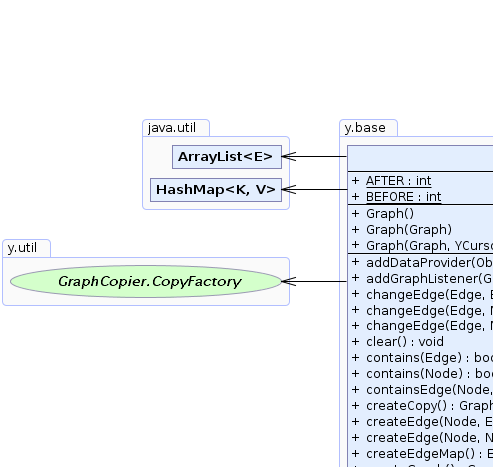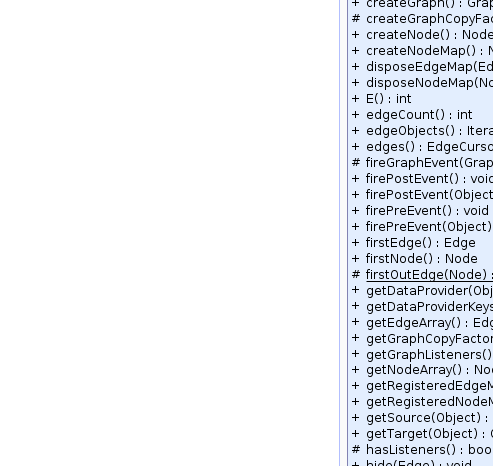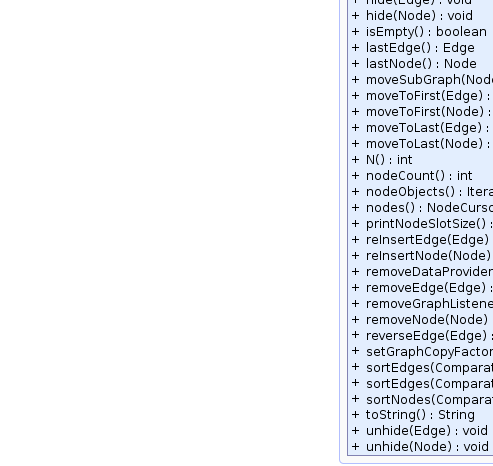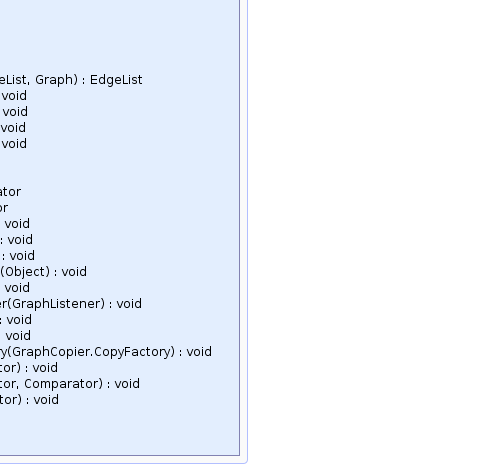 y.base.Graph
y.base.Graph
|
Search this API | ||||||||
| PREV CLASS NEXT CLASS | FRAMES NO FRAMES | ||||||||
| SUMMARY: NESTED | FIELD | CONSTR | METHOD | DETAIL: FIELD | CONSTR | METHOD | ||||||||
java.lang.Objecty.base.Graph
public class Graph
This class implements a directed graph structure.
Basically, a directed graph consists of a set of objects called "nodes" (represented
by instances of class Node) and a set of node pairs which are called
"edges" (represented by instances of class Edge).
The directed stems from the fact that all edges in the graph have direction,
i.e., they have a distinct source node and a distinct target node.
Using the aforementioned pair notation, an edge would be written as
(<source node>, <target node>).
NodeCursor) and edge set (interface
EdgeCursor).
Class Graph fires notification events that signal structural changes, like, e.g.,
creation, removal, reinsertion, or modification of graph elements.
GraphListener interface can be registered
with this class using the addGraphListener
method in order to receive such events.
This class provides direct support for the notion of data accessors.
It allows to register so-called data providers (implementations of interface
DataProvider) that hold arbitrary data which is associated to its nodes
and/or edges.
NodeMap,
EdgeMap) that can be utilized to bind arbitrary data to nodes and edges.
 |
 |
 |
 |
 |
 |
| Field Summary | |
|---|---|
static int |
AFTER
Object insertion specifier. |
static int |
BEFORE
Object insertion specifier. |
| Constructor Summary | |
|---|---|
Graph()
Instantiates an empty Graph object. |
|
Graph(Graph argGraph)
Instantiates a new Graph object as a copy of the given graph. |
|
Graph(Graph graph,
YCursor subNodes)
Instantiates a new Graph object as a partial copy of the given graph. |
|
| Method Summary | |
|---|---|
void |
addDataProvider(java.lang.Object providerKey,
DataProvider data)
Registers the given data provider using the given look-up key. |
void |
addGraphListener(GraphListener listener)
Registers the given graph listener with this graph. |
void |
changeEdge(Edge e,
Edge e1,
Edge e2,
int d1,
int d2)
Redefines an edge's end points and fires corresponding notification events to inform registered listeners. |
void |
changeEdge(Edge e,
Node newSource,
Edge sourceReference,
int sourceD,
Node newTarget,
Edge targetReference,
int targetD)
Redefines an edge's end points and fires corresponding notification events to inform registered listeners. |
void |
changeEdge(Edge e,
Node newSource,
Node newTarget)
Redefines an edge's end points and fires corresponding notification events to inform registered listeners. |
void |
clear()
Removes all nodes and edges from this graph and fires corresponding notification events to inform registered listeners. |
boolean |
contains(Edge e)
Whether or not this graph contains the given edge. |
boolean |
contains(Node v)
Whether or not this graph contains the given node. |
boolean |
containsEdge(Node source,
Node target)
Returns whether or not this graph contains an edge that connects the given nodes. |
Graph |
createCopy()
Creates a copy of this graph. |
Edge |
createEdge(Node v,
Edge e1,
Node w,
Edge e2,
int d1,
int d2)
Creates a new edge in this graph to be ordered before or after a given edge and fires a corresponding notification event to inform registered listeners. |
Edge |
createEdge(Node v,
Node w)
Creates a new edge in this graph and fires a corresponding notification event to inform registered listeners. |
EdgeMap |
createEdgeMap()
Returns a newly created edge map that is valid for the edges in this graph. |
Graph |
createGraph()
Creates an empty base object of the same type as this graph. |
protected GraphCopier.CopyFactory |
createGraphCopyFactory()
Factory method that is called by getGraphCopyFactory()
to create a (possibly shared) instance. |
Node |
createNode()
Creates a new node in this graph and fires a corresponding notification event to inform registered listeners. |
NodeMap |
createNodeMap()
Returns a newly created node map that is valid for the nodes in this graph. |
void |
disposeEdgeMap(EdgeMap map)
Informs the graph that the given edge map is no longer needed. |
void |
disposeNodeMap(NodeMap map)
Informs the graph that the given node map is no longer needed. |
int |
E()
Returns the number of edges in this graph. |
int |
edgeCount()
Returns the number of edges in this graph. |
java.util.Iterator |
edgeObjects()
Returns an iterator that provides access to all edges residing in this graph. |
EdgeCursor |
edges()
Provides access to the edges of the graph. |
protected void |
fireGraphEvent(GraphEvent e)
Propagates the given graph event to all registered graph listeners. |
void |
firePostEvent()
Propagates a so-called POST event to all registered graph listeners. |
void |
firePostEvent(java.lang.Object id)
Like firePostEvent(). |
void |
firePreEvent()
Propagates a so-called PRE event to all registered graph listeners. |
void |
firePreEvent(java.lang.Object id)
Like firePreEvent(). |
Edge |
firstEdge()
Returns the first edge in this graph. |
Node |
firstNode()
Returns the first node in this graph. |
protected static Edge |
firstOutEdge(Node v)
Low-level iteration support for adjacent edges. |
DataProvider |
getDataProvider(java.lang.Object providerKey)
Returns the data provider that is registered with the graph using the given look-up key. |
java.lang.Object[] |
getDataProviderKeys()
Returns an array of all data provider look-up keys that are registered with this graph. |
Edge[] |
getEdgeArray()
Returns an array containing all edges of this graph. |
GraphCopier.CopyFactory |
getGraphCopyFactory()
Returns the copy factory that is associated with this instance. |
java.util.Iterator |
getGraphListeners()
Returns an iterator that grants access to all registered graph listeners. |
Node[] |
getNodeArray()
Returns an array containing all nodes of this graph. |
EdgeMap[] |
getRegisteredEdgeMaps()
Returns all edge maps that have been created by this graph but have not yet been disposed. |
NodeMap[] |
getRegisteredNodeMaps()
Returns all node maps that have been created by this graph but have not yet been disposed. |
java.lang.Object |
getSource(java.lang.Object edge)
Returns the source node associated with the given edge. |
java.lang.Object |
getTarget(java.lang.Object edge)
Returns the target node associated with the given edge. |
protected boolean |
hasListeners()
Determines whether there are listeners registered with this instance. |
void |
hide(Edge e)
Hides the given edge from this graph. |
void |
hide(Node v)
Hides the given node from this graph. |
boolean |
isEmpty()
Returns true if this graph contains no nodes. |
Edge |
lastEdge()
Returns the last edge in this graph. |
Node |
lastNode()
Returns the last node in this graph. |
EdgeList |
moveSubGraph(NodeList subNodes,
Graph targetGraph)
Moves an induced subgraph to another graph. |
void |
moveToFirst(Edge e)
Moves the given edge to the first position within the sequence of edges in this graph. |
void |
moveToFirst(Node v)
Moves the given node to the first position within the sequence of nodes in this graph. |
void |
moveToLast(Edge e)
Moves the given edge to the last position within the sequence of edges in this graph. |
void |
moveToLast(Node v)
Moves the given node to the last position within the sequence of nodes in this graph. |
int |
N()
Returns the number of nodes in this graph. |
int |
nodeCount()
Returns the number of nodes in this graph. |
java.util.Iterator |
nodeObjects()
Returns an iterator that provides access to all nodes residing in this graph. |
NodeCursor |
nodes()
Provides access to the nodes of the graph. |
void |
printNodeSlotSize()
For internal debugging purposes only. |
void |
reInsertEdge(Edge e)
Reinserts a formerly removed edge into this graph and fires a corresponding notification event to inform registered listeners. |
void |
reInsertNode(Node v)
Reinserts a formerly removed node into this graph and fires a corresponding notification event to inform registered listeners. |
void |
removeDataProvider(java.lang.Object providerKey)
Removes the data provider that is registered using the given look-up key. |
void |
removeEdge(Edge e)
Removes the given edge from this graph and fires a corresponding notification event to inform registered listeners. |
void |
removeGraphListener(GraphListener listener)
Removes the given graph listener from this graph. |
void |
removeNode(Node v)
Removes the given node from this graph. |
void |
reverseEdge(Edge e)
Reverses the given edge and fires corresponding notification events to inform registered listeners. |
void |
setGraphCopyFactory(GraphCopier.CopyFactory copyFactory)
Sets the copy factory that is associated with this instance. |
void |
sortEdges(java.util.Comparator comp)
Sorts the internally held list of edges. |
void |
sortEdges(java.util.Comparator inComp,
java.util.Comparator outComp)
Sorts incoming and outgoing edges at each node of the graph. |
void |
sortNodes(java.util.Comparator comp)
Sorts the internally held list of nodes. |
java.lang.String |
toString()
Returns a String representation of this graph. |
void |
unhide(Edge e)
Unhides the given edge in this graph. |
void |
unhide(Node v)
Unhides the given node in this graph. |
| Methods inherited from class java.lang.Object |
|---|
clone, equals, finalize, getClass, hashCode, notify, notifyAll, wait, wait, wait |
| Field Detail |
|---|
public static final int BEFORE
public static final int AFTER
| Constructor Detail |
|---|
public Graph()
Graph object.
public Graph(Graph argGraph)
Graph object as a copy of the given graph.
Values bound to the argument graph via node and edge keys are available in
the new Graph instance with the keys registered with argGraph.
Only references to these values are copied.
The new Graph instance also inherits all graph listeners registered with the
given graph.
This constructor does not use a GraphCopier.
argGraph - The graph to be copied.
public Graph(Graph graph,
YCursor subNodes)
Graph object as a partial copy of the given graph.
Only the subgraph induced by the given cursor will be copied to the new Graph
instance.
Values bound to the argument graph via node and edge keys are available in
the new Graph instance with the keys registered with graph.
Only references to these values are copied.
The new Graph instance also inherits all graph listeners registered with the
given graph.
This constructor does not use a GraphCopier.
graph - The graph to be (partially) copied.subNodes - A cursor to iterate over the nodes that actually induce the subgraph to be
copied.| Method Detail |
|---|
public GraphCopier.CopyFactory getGraphCopyFactory()
createGraphCopyFactory() (if no
instance has been specified before).
createGraphCopyFactory(),
setGraphCopyFactory(y.util.GraphCopier.CopyFactory)protected GraphCopier.CopyFactory createGraphCopyFactory()
getGraphCopyFactory()
to create a (possibly shared) instance.
public void setGraphCopyFactory(GraphCopier.CopyFactory copyFactory)
createGraphCopyFactory() (if no
instance has been specified before).
copyFactory - the new factory to use.createGraphCopyFactory(),
setGraphCopyFactory(y.util.GraphCopier.CopyFactory)protected final boolean hasListeners()
public Graph createCopy()
Graph(Graph).
public Node createNode()
public Edge createEdge(Node v,
Node w)
v and target node w,
i.e., would be written as edge e = (v, w).
The edge is appended to the lists of incoming and outgoing edges at the source
node and target node, respectively.
v - The source node of the edge.w - The target node of the edge.
public Edge createEdge(Node v,
Edge e1,
Node w,
Edge e2,
int d1,
int d2)
e has source node v and target node
w, i.e., would be written as edge e = (v, w).
e is inserted in such a way that an iteration over the edges
at node v returns e
e1, if d1 == AFTER
e1, if d1 == BEFORE,
w returns e
e2, if d2 == AFTER
e2, if d2 == BEFORE.
e1 must have source node v
and
edge e2 must have target node w.v - The source node of the edge.e1 - An edge with source node v.w - The target node of the edge.e2 - An edge with target node w.d1 - One of the object insertion specifiers BEFORE or AFTER.d2 - One of the object insertion specifiers BEFORE or AFTER.
public void removeNode(Node v)
v - The node to be removed from this graph.public void removeEdge(Edge e)
e - The edge to be removed.public void reInsertNode(Node v)
v - The node to be reinserted.removeNode(Node)public void reInsertEdge(Edge e)
Note that reinserting an edge whose source/target is not in the graph (e.g., because it's currently hidden/removed) causes an exception. Hence, in such cases, you first have to unhide/reinsert the corresponding endpoints.
e - The edge to be reinserted.removeEdge(Edge)
public void changeEdge(Edge e,
Edge e1,
Edge e2,
int d1,
int d2)
e has
source node v := e1.source()
and
target node w := e2.target().
e is inserted in such a way that an iteration over the edges
at v returns e
e1, if d1 == AFTER
e1, if d1 == BEFORE,
w returns e
e2, if d2 == AFTER
e2, if d2 == BEFORE.
e, e1, and e2 must belong to this
graph.e - The edge to be changed.e1 - Reference edge for insertion at a new source node.e2 - Reference edge for insertion at a new target node.d1 - One of the object insertion specifiers BEFORE or AFTER.d2 - One of the object insertion specifiers BEFORE or AFTER.
public void changeEdge(Edge e,
Node newSource,
Edge sourceReference,
int sourceD,
Node newTarget,
Edge targetReference,
int targetD)
e has
source node v := sourceReference.source() or v := newSource,
if sourceReference == null
and
target node w := targetReference.target() or w := newTarget,
if targetReference == null.
e is inserted in such a way that an iteration over the edges
at v returns e
sourceReference, if sourceD == AFTER
sourceReference, if sourceD == BEFORE,
w returns e
targetReference, if targetD == AFTER
targetReference, if targetD == BEFORE.
e must belong to this graph.
Also, either sourceReference or newSource must be
non-null and belong to this graph, and either targetReference
or newTarget must be non-null and belong to this graph.e - The edge to be changed.newSource - The new source node.sourceReference - Reference edge for insertion at the new source node.sourceD - One of the object insertion specifiers BEFORE or AFTER.newTarget - The new target node.targetReference - Reference edge for insertion at the new target node.targetD - One of the object insertion specifiers BEFORE or AFTER.
public void changeEdge(Edge e,
Node newSource,
Node newTarget)
newSource and newTarget must belong to this graph.e - The edge to be changed.newSource - The new source node of the given edge.newTarget - The new target node of the given edge.public void reverseEdge(Edge e)
public void hide(Edge e)
removeEdge(Edge)
is that no GraphEvent will be emitted that signals the structural change
(i.e. the edge's removal).
Generally, hiding should only be used in the sense of temporarily removing
an object that will be reinserted shortly after.
To reinsert a hidden edge use unhide(Edge).
hide(Node),
unhide(Node)public void unhide(Edge e)
hide(Edge).
The only difference to a proper edge reinsertion as performed by reInsertEdge(Edge)
is that no GraphEvent will be emitted that signals the structural change
(i.e. the edge's reinsertion).
Note that unhiding an edge whose source/target is not in the graph (e.g., because it's currently hidden/removed) causes an exception. Hence, in such cases, you first have to unhide/reinsert the corresponding endpoints.
hide(Node),
unhide(Node)public void hide(Node v)
removeNode(Node)
is that no GraphEvent will be emitted that signals the structural change
(i.e. the node's removal).
Generally, hiding should only be used in the sense of temporarily removing
an object that will be reinserted shortly after.
To reinsert a hidden node use unhide(Node).
hide(Edge),
unhide(Edge)public void unhide(Node v)
hide(Node).
The only difference to a proper node reinsertion as performed by reInsertNode(Node)
is that no GraphEvent will be emitted that signals the structural change
(i.e. the node's reinsertion).
public void moveToLast(Node v)
public void moveToFirst(Node v)
public void moveToLast(Edge e)
public void moveToFirst(Edge e)
public int N()
nodeCount().
public int nodeCount()
public int E()
edgeCount().
public int edgeCount()
public boolean isEmpty()
true if this graph contains no nodes.
true if this graph contains no nodes, otherwise false.public void clear()
public boolean contains(Node v)
public boolean contains(Edge e)
public boolean containsEdge(Node source,
Node target)
source - The source node.target - The target node.Node.getEdgeTo(Node),
Node.getEdgeFrom(Node),
Node.getEdge(Node)public Node firstNode()
!isEmpty()public Edge firstEdge()
edgeCount() > 0public Node lastNode()
!isEmpty()public Edge lastEdge()
edgeCount() > 0public Node[] getNodeArray()
public Edge[] getEdgeArray()
public NodeCursor nodes()
public EdgeCursor edges()
public EdgeList moveSubGraph(NodeList subNodes,
Graph targetGraph)
subNodes must belong to this
graph.subNodes - A list of nodes that induce the subgraph to be moved.targetGraph - The graph where the subgraph is moved to.
public Graph createGraph()
public void sortEdges(java.util.Comparator comp)
null, then the edges will not be sorted.
This list determines the order of the edges as returned by edges().
comp - The comparator used for the edges.public void sortNodes(java.util.Comparator comp)
null, then the nodes will not be sorted.
This list determines the order of the nodes as returned by nodes().
comp - The comparator used for the nodes.
public void sortEdges(java.util.Comparator inComp,
java.util.Comparator outComp)
null, then the corresponding edges (i.e.,
incoming/outgoing) will not be sorted.
This sorts the order of the edges as returned by Node.outEdges()
and Node.inEdges() respectively.
inComp - The comparator used for the incoming edges at each node.outComp - The comparator used for the outgoing edges at each node.public void addGraphListener(GraphListener listener)
GraphEventpublic void removeGraphListener(GraphListener listener)
public java.util.Iterator getGraphListeners()
public void firePreEvent()
firePostEvent()
follows.
Generally, PRE and POST events serve as a means to bracket a sequence of graph
events.
GraphListenerpublic void firePreEvent(java.lang.Object id)
firePreEvent().
Additionally, an event ID may be specified.
id - An identifying tag for the event.GraphListenerpublic void firePostEvent()
firePreEvent()
was made.
Generally, PRE and POST events serve as a means to bracket a sequence of graph
events.
GraphListenerpublic void firePostEvent(java.lang.Object id)
firePostEvent().
Additionally, an event ID may be specified.
id - An identifying tag for the event.GraphListenerprotected void fireGraphEvent(GraphEvent e)
public NodeMap createNodeMap()
O(n) memory at all times and
provides true O(1) read and write access for each node.
In order to release the resources held by this map, disposeNodeMap(NodeMap)
has to be called.
public EdgeMap createEdgeMap()
O(m) memory at all times and
provides true O(1) read and write access for each edge.
In order to release the resources held by this map, disposeEdgeMap(EdgeMap)
has to be called.
public void disposeNodeMap(NodeMap map)
createNodeMap() factory method.
Calling this method will destroy the node map and associated resources can
be freed.
It is strongly recommended to dispose of all node maps that are not needed
anymore using this method.
public void disposeEdgeMap(EdgeMap map)
createEdgeMap() factory method.
Calling this method will destroy the edge map and associated resources can
be freed.
It is strongly recommended to dispose of all edge maps that are not needed
anymore using this method.
public NodeMap[] getRegisteredNodeMaps()
createNodeMap(),
disposeNodeMap(NodeMap)public EdgeMap[] getRegisteredEdgeMaps()
createEdgeMap(),
disposeEdgeMap(EdgeMap)public java.lang.Object getSource(java.lang.Object edge)
getSource in interface GraphInterfacepublic java.lang.Object getTarget(java.lang.Object edge)
getTarget in interface GraphInterfacepublic java.util.Iterator nodeObjects()
nodeObjects in interface GraphInterfacepublic java.util.Iterator edgeObjects()
edgeObjects in interface GraphInterfacepublic DataProvider getDataProvider(java.lang.Object providerKey)
getDataProvider in interface GraphInterface
public void addDataProvider(java.lang.Object providerKey,
DataProvider data)
public void removeDataProvider(java.lang.Object providerKey)
public java.lang.Object[] getDataProviderKeys()
getDataProviderKeys in interface GraphInterfaceprotected static final Edge firstOutEdge(Node v)
public void printNodeSlotSize()
public java.lang.String toString()
toString in class java.lang.Object
|
© Copyright 2000-2025, yWorks GmbH. All rights reserved. |
||||||||
| PREV CLASS NEXT CLASS | FRAMES NO FRAMES | ||||||||
| SUMMARY: NESTED | FIELD | CONSTR | METHOD | DETAIL: FIELD | CONSTR | METHOD | ||||||||